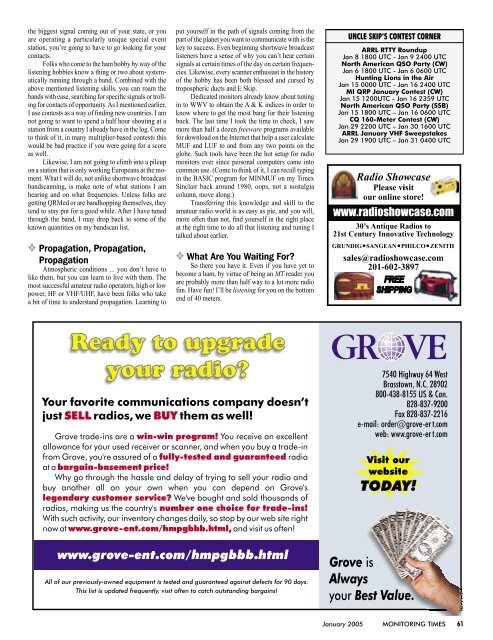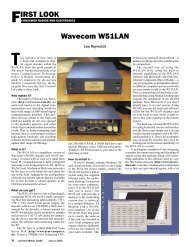MT Express Sample Low Resolution Issue ... - Monitoring Times
MT Express Sample Low Resolution Issue ... - Monitoring Times
MT Express Sample Low Resolution Issue ... - Monitoring Times
You also want an ePaper? Increase the reach of your titles
YUMPU automatically turns print PDFs into web optimized ePapers that Google loves.
the biggest signal coming out of your state, or you<br />
are operating a particularly unique special event<br />
station, you’re going to have to go looking for your<br />
contacts.<br />
Folks who come to the ham hobby by way of the<br />
listening hobbies know a thing or two about systematically<br />
running through a band. Combined with the<br />
above mentioned listening skills, you can roam the<br />
bands with ease, searching for specific signals or trolling<br />
for contacts of opportunity. As I mentioned earlier,<br />
I use contests as a way of finding new countries. I am<br />
not going to want to spend a half hour shouting at a<br />
station from a country I already have in the log. Come<br />
to think of it, in many multiplier-based contests this<br />
would be bad practice if you were going for a score<br />
as well.<br />
Likewise, I am not going to climb into a pileup<br />
on a station that is only working Europeans at the moment.<br />
What I will do, not unlike shortwave broadcast<br />
bandscanning, is make note of what stations I am<br />
hearing and on what frequencies. Unless folks are<br />
getting QRMed or are bandhopping themselves, they<br />
tend to stay put for a good while. After I have tuned<br />
through the band, I may drop back to some of the<br />
known quantities on my bandscan list.<br />
❖ Propagation, Propagation,<br />
Propagation<br />
Atmospheric conditions ... you don’t have to<br />
like them, but you can learn to live with them. The<br />
most successful amateur radio operators, high or low<br />
power, HF or VHF/UHF, have been folks who take<br />
a bit of time to understand propagation. Learning to<br />
put yourself in the path of signals coming from the<br />
part of the planet you want to communicate with is the<br />
key to success. Even beginning shortwave broadcast<br />
listeners have a sense of why you can’t hear certain<br />
signals at certain times of the day on certain frequencies.<br />
Likewise, every scanner enthusiast in the history<br />
of the hobby has been both blessed and cursed by<br />
tropospheric ducts and E Skip.<br />
Dedicated monitors already know about tuning<br />
in to WWV to obtain the A & K indices in order to<br />
know where to get the most bang for their listening<br />
buck. The last time I took the time to check, I saw<br />
more than half a dozen freeware programs available<br />
for download on the Internet that help a user calculate<br />
MUF and LUF to and from any two points on the<br />
globe. Such tools have been the hot setup for radio<br />
monitors ever since personal computers came into<br />
common use. (Come to think of it, I can recall typing<br />
in the BASIC program for MINMUF on my Timex<br />
Sinclair back around 1980, oops, not a nostalgia<br />
column, move along.)<br />
Transferring this knowledge and skill to the<br />
amateur radio world is as easy as pie, and you will,<br />
more often than not, find yourself in the right place<br />
at the right time to do all that listening and tuning I<br />
talked about earlier.<br />
❖ What Are You Waiting For?<br />
So there you have it. Even if you have yet to<br />
become a ham, by virtue of being an <strong>MT</strong> reader you<br />
are probably more than half way to a lot more radio<br />
fun. Have fun! I’ll be listening for you on the bottom<br />
end of 40 meters.<br />
UNCLE SKIP’S CONTEST CORNER<br />
ARRL RTTY Roundup<br />
Jan 8 1800 UTC - Jan 9 2400 UTC<br />
North American QSO Party (CW)<br />
Jan 6 1800 UTC - Jan 6 0600 UTC<br />
Hunting Lions in the Air<br />
Jan 15 0000 UTC - Jan 16 2400 UTC<br />
MI QRP January Contest (CW)<br />
Jan 15 1200UTC - Jan 16 2359 UTC<br />
North American QSO Party (SSB)<br />
Jan 15 1800 UTC – Jan 16 0600 UTC<br />
CQ 160-Meter Contest (CW)<br />
Jan 29 2200 UTC – Jan 30 1600 UTC<br />
ARRL January VHF Sweepstakes<br />
Jan 29 1900 UTC – Jan 31 0400 UTC<br />
January 2005 MONITORING TIMES 61
















